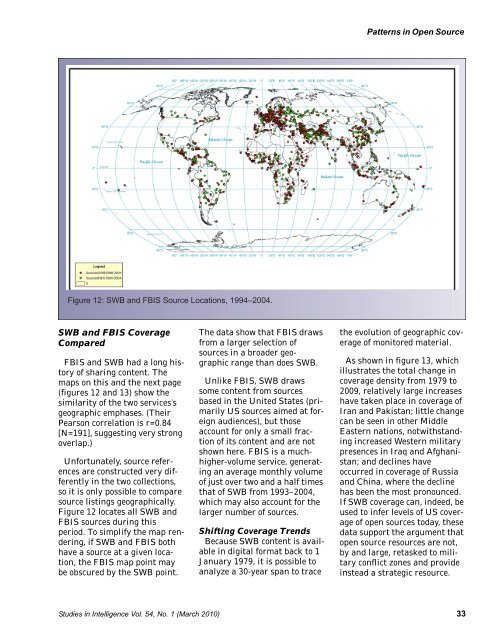Studies in Intelligence - The Black Vault
Studies in Intelligence - The Black Vault
Studies in Intelligence - The Black Vault
Create successful ePaper yourself
Turn your PDF publications into a flip-book with our unique Google optimized e-Paper software.
Patterns <strong>in</strong> Open Source<br />
Figure 12: SWB and FBIS Source Locations, 1994–2004.<br />
SWB and FBIS Coverage<br />
Compared<br />
FBIS and SWB had a long history<br />
of shar<strong>in</strong>g content. <strong>The</strong><br />
maps on this and the next page<br />
(figures 12 and 13) show the<br />
similarity of the two services’s<br />
geographic emphases. (<strong>The</strong>ir<br />
Pearson correlation is r=0.84<br />
[N=191], suggest<strong>in</strong>g very strong<br />
overlap.)<br />
Unfortunately, source references<br />
are constructed very differently<br />
<strong>in</strong> the two collections,<br />
so it is only possible to compare<br />
source list<strong>in</strong>gs geographically.<br />
Figure 12 locates all SWB and<br />
FBIS sources dur<strong>in</strong>g this<br />
period. To simplify the map render<strong>in</strong>g,<br />
if SWB and FBIS both<br />
have a source at a given location,<br />
the FBIS map po<strong>in</strong>t may<br />
be obscured by the SWB po<strong>in</strong>t.<br />
<strong>The</strong> data show that FBIS draws<br />
from a larger selection of<br />
sources <strong>in</strong> a broader geographic<br />
range than does SWB.<br />
Unlike FBIS, SWB draws<br />
some content from sources<br />
based <strong>in</strong> the United States (primarily<br />
US sources aimed at foreign<br />
audiences), but those<br />
account for only a small fraction<br />
of its content and are not<br />
shown here. FBIS is a muchhigher-volume<br />
service, generat<strong>in</strong>g<br />
an average monthly volume<br />
of just over two and a half times<br />
that of SWB from 1993–2004,<br />
which may also account for the<br />
larger number of sources.<br />
Shift<strong>in</strong>g Coverage Trends<br />
Because SWB content is available<br />
<strong>in</strong> digital format back to 1<br />
January 1979, it is possible to<br />
analyze a 30-year span to trace<br />
the evolution of geographic coverage<br />
of monitored material.<br />
As shown <strong>in</strong> figure 13, which<br />
illustrates the total change <strong>in</strong><br />
coverage density from 1979 to<br />
2009, relatively large <strong>in</strong>creases<br />
have taken place <strong>in</strong> coverage of<br />
Iran and Pakistan; little change<br />
can be seen <strong>in</strong> other Middle<br />
Eastern nations, notwithstand<strong>in</strong>g<br />
<strong>in</strong>creased Western military<br />
presences <strong>in</strong> Iraq and Afghanistan;<br />
and decl<strong>in</strong>es have<br />
occurred <strong>in</strong> coverage of Russia<br />
and Ch<strong>in</strong>a, where the decl<strong>in</strong>e<br />
has been the most pronounced.<br />
If SWB coverage can, <strong>in</strong>deed, be<br />
used to <strong>in</strong>fer levels of US coverage<br />
of open sources today, these<br />
data support the argument that<br />
open source resources are not,<br />
by and large, retasked to military<br />
conflict zones and provide<br />
<strong>in</strong>stead a strategic resource.<br />
<strong>Studies</strong> <strong>in</strong> <strong>Intelligence</strong> Vol. 54, No. 1 (March 2010) 33





![Combat Support in Korea [270 Pages] - The Black Vault](https://img.yumpu.com/49796461/1/190x71/combat-support-in-korea-270-pages-the-black-vault.jpg?quality=85)











